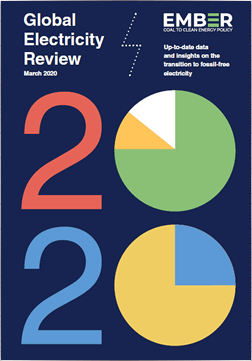Global Electricity Review 2020
This report released by the independent climate think-tank Ember gives unbiased insights into last year’s global electricity generation changes. It incorporates 2019 electricity generation data covering 85% of world’s electricity generation, and informed estimates of the remaining 15%.
The report offers an unbiased picture of the transition to fossil-free electricity.
Key findings:
- Global coal-fired electricity generation fell by 3% in 2019, leading to a 2% fall in CO2 power sector emissions. Both of these are the biggest falls since at least 1990. Coal collapsed in the EU and the US; but Chinese coal generation rose and for the first time was responsible for half of global coal generation. The carbon-intensity of global electricity is now 15% lower than in 2010.
- But falling coal generation is not yet the “new normal”, which means limiting climate change to 1.5 degrees is looking extremely difficult. The coal fall in 2019, as well as relying on the structural shift towards wind and solar, relied on many other one-off factors. Progress is being made on reducing coal generation, but with nothing like the urgency needed to meet global climate goals, especially in Asia.
- Wind and solar generation rose by 15% in 2019, generating 8% of the world’s electricity. Compound growth rate of 15% of wind and solar generation is needed every year to meet the Paris climate agreement. This was achieved in 2019 and lower prices provide hope it can be sustained. However, maintaining this high growth rate as volumes scale up will require a concerted effort from all regions.
- The US coal collapse is undermined by a switch to gas, whereas the EU is leapfrogging from coal to wind and solar. Coal generation collapsed by 24% in the EU and 16% in the US in 2019, and is now half the level of 2007 in both the EU and US. Since 2007, US CO2 power sector emissions fell by 19-32%, whereas they fell by 43% in the EU.
Details
- Source: Ember
- Source Link: https://ember-climate.org
- Publication Date: 03/2020
